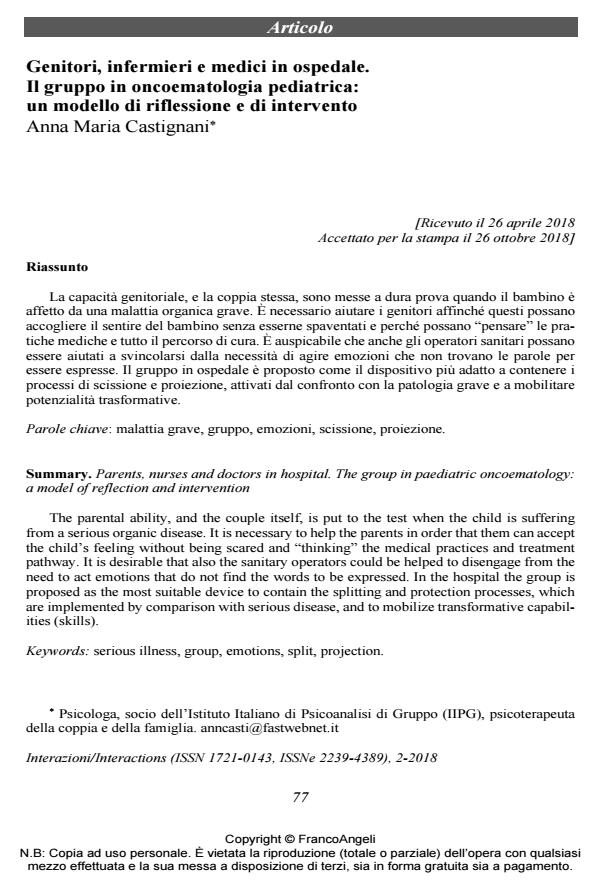Parents, nurses and doctors in hospital. The group in paediatric oncoematology: a model of reflection and intervention
Journal title INTERAZIONI
Author/s Anna Maria Castignani
Publishing Year 2018 Issue 2018/2
Language Italian Pages 17 P. 77-93 File size 212 KB
DOI 10.3280/INT2018-002007
DOI is like a bar code for intellectual property: to have more infomation
click here
Below, you can see the article first page
If you want to buy this article in PDF format, you can do it, following the instructions to buy download credits

FrancoAngeli is member of Publishers International Linking Association, Inc (PILA), a not-for-profit association which run the CrossRef service enabling links to and from online scholarly content.
The parental ability, and the couple itself, is put to the test when the child is suffering from a serious organic disease. It is necessary to help the parents in order that them can accept the child’s feeling without being scared and "thinking" the medical practices and treatment pathway. It is desirable that also the sanitary operators could be helped to disengage from the need to act emotions that do not find the words to be expressed. In the hospital the group is proposed as the most suitable device to contain the splitting and protection processes, which are implemented by comparison with serious disease, and to mobilize transformative capabilities (skills).
Keywords: Serious illness, group, emotions, split, projection.
- Armenti C., Trabucco O., Tulimieri E. (2015). L’esperienza di malattia: uno spazio di pensiero in un DH Onco-Ematologico pediatrico. Richard e Piggle, 23, 4: 404-420.
- Bion W.R. (1962). Apprendere dall’esperienza. Roma: Armando, 1972.
- Castignani A.M. (2007). Il gruppo in ospedale: tra bisogni fisici e psichici. Koinos Gruppo e funzione analitica, 28, 1-2: 129-148.
- Di Cagno L., Massaglia P. (1990). Il rischio di sviluppo atipico nei bambini affetti da malattia cronica ad esordio precoce. Psichiatria dell’infanzia e dell’adolescenza, 57: 35-46.
- James H. (1964). Le ali della colomba. Milano: Bur, 1997.
- Lugones M. (2002). Introduzione. In Lugones M. (a cura di), Tra Pediatria e Psicoterapia. Quaderni di Psicoterapia Infantile, 44. Roma: Borla.
- Ogden T.H. (2007). Elements of analytic style: Bion’s clinical seminars. International Journal of Psychoanalysis, LXXXVIII, 5: 1185-1200.
- Petrelli D. (2015). Il corpo malato: relazioni terapeutiche con bambini e adolescenti. Richard e Piggle, 23, 4: 361-369.
- Ruszniewski M. (2000). Di fronte alla malattia grave. Roma: Borla.
- Tavazza G. (2007). Oltre il “camice”. Interazioni, 2: 65-66.
- Woolf V. (1930). Sulla malattia. Torino: Bollati Boringhieri, 2006.
Anna Maria Castignani, Genitori, infermieri e medici in ospedale. Il gruppo in oncoematologia pediatrica: un modello di riflessione e di intervento in "INTERAZIONI" 2/2018, pp 77-93, DOI: 10.3280/INT2018-002007